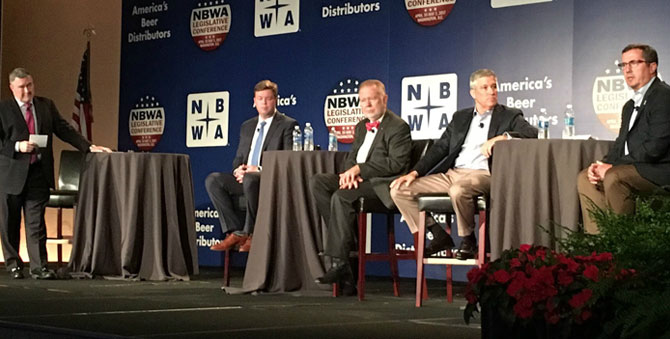
The continued proliferation of brewery-owned retail outposts was the topic of discussion during the annual National Beer Wholesalers Association (NBWA) legislative conference, held Monday in Washington, D.C.
Weighing in on the growing impact that taprooms are having across all three tiers of the beer industry were Craig Purser, the CEO of the NBWA; Bob Pease, the CEO of the Brewers Association; and John Bodnovich, the executive director of American Beverage Licensees.
Speaking to hundreds of beer distributors from all 50 states, Purser called the “aggressive” expansion of brewery taprooms an “emerging issue,” and characterized them as “modern day tied houses.”
“Nobody should be surprised when some states take action to clarify retail privileges,” he said.

In a follow-up interview with Brewbound, Purser defended the three-tier system but wouldn’t say definitively whether the NBWA supported or opposed the continued expansion of brewery-owned taprooms.
“This is a conversation that we need to have,” he said. “People shouldn’t be surprised if one tier or a group of interests acts unilaterally to oppose it. In most cases, it is a tied house exemption, and there may be opposition to that, particularly if it is beyond the scope of the intent of the exemption.”
In contrast, Pease, who as CEO of the BA represents the interests of more than 5,000 small and independent U.S. brewers, seemed to show greater support for brewers growing via direct-to-consumer sales.
“I think everyone knows the prognostication for the future — it is pretty flat,” he said of future growth potential within the overall beer segment. “Taprooms and tasting rooms — that is where the epicenter of brand building is happening.
“We need to grow the category, and that is where the excitement is,” he added, noting that the debate around brewery taprooms was “complicated.”
Last month, BA chief economist Bart Watson examined the growth of “own-premise” sales, estimating that 2.3 million barrels of beer (approximately 9.4 percent of BA-defined craft beer production) flowed through taprooms and brewery retail outposts in 2016, up 7 percent versus 2015.
“Category growth in onsite sales is coming more from the proliferation of breweries that begin with onsite as a large portion of their business model rather than a strong shift within existing breweries toward onsite sales,” Watson argued. “70%+ of craft breweries are 1,000 barrels or less, and while they only represent 5% of craft production, with 65-70% of their sales occurring at the brewery, they account for almost 40% of craft’s onsite sales.”
Bodnovich, who represents on- and off-premise retailers, challenged that point of view, however.
“I think it is easy to fall into the trap of saying that it is just the small guys,” he said. “I think it transcends both large and small.”
Bodnovich also said he expects “more scrutiny and analysis” in the coming months.
That type of scrutiny has already taken place in Texas, where a the proposed House Bill 3287 and sister bill SB 2083, backed by the state’s wholesalers, would significantly alter a Texas law that currently gives beer manufacturers who produce less than 225,000 barrels of beer annually the right to sell as much as 5,000 barrels directly to consumers via their taprooms.
The proposed language change would count production occurring at facilities “owned directly or indirectly by the license holder or an affiliate or subsidiary” toward the 225,000-barrel limit, meaning several breweries would have to shutter their taprooms.
Editor’s note: The topic of brewery-owned taprooms will be discussed at the upcoming Brewbound Session, taking place on June 15 in New York City. A trio of prominent on-premise operators – Yard House, World of Beer and Winking Lizard – will discuss brewery-to-consumer sales and explain how taprooms are disrupting the more traditional retail business.
